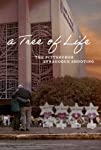Eye For Film >> Movies >> A Tree Of Life (2021) Film Review
A Tree Of Life
Reviewed by: Jennie Kermode

It was the 27th of October, 2018. A fortunate day, perhaps, in that it was the one shabbat in the month when there was no youth congregation, though the killer didn’t know that. When he went upstairs looking for them, the kids weren’t there, but by then he had already fired 20 to 30 shots, as we hear on recordings of police audio. 11 people would die that day and six more would be seriously wounded. It was the single deadliest anti-Semitic attack ever committed on US soil. This HBO documentary helmed by Trish Adlesic, herself a native of Pittsburgh, meets the survivors to reveal their stories and see how they have learned to live with what happened.
Adlesic interviews members of all three congregations present on that day: the Tree of Life, the Dor Hadash and the New Light, each with a different religious perspective yet comfortable sharing space. From the outside the building looks dull, concrete and streaked grey glass, perhaps already unconsciously linked with mourning. On the inside, the light filters brilliantly through the stained glass panes, filling it up with colour and, still, life. We move around it, visiting the places where people hid, the places where bodies fell. Survivors remember people arriving a little late that day – “We call it Jewish Standard Time” – and remember a rabbi pausing to give congregants the chance to check the sports scores. There is talk about who made a special effort to be there that day, who had the good fortune to feel under the weather and decide to stay at home.

The human stories come first. The politics emerge slowly, as they must have done on the day, that confusion over what the noise was followed by panic and then by questions as to why it was happening. Nobody had been under any illusions about the presence of anti-Semitism in US society or the increasing boldness of the far right, but it’s another thing to face it directly in such a shocking way. In the latter part of the film we learn a little about the shooter, though he is never allowed to take up space which belongs to the survivors. We see some of the extremist propaganda he consumed, including a video which claims that the right wings attack on the US Capitol building was a Jewish false flag operation and makes a musical choice which seems aimed at offending as many groups as possible. It also emerges that the synagogue was targeted in part because of the work it did to support immigrants, so it’s clear that a more general xenophobia was at work.
Memories provides snapshots of a chaotic experience. Dan Leger talks about how because he was a nurse and his friend Jerry Rabinowitz a doctor, they thought they could help, so moved in the direction of the gunfire. Martin Gaynor recalls how amazing all the first responders were, risking their own lives to save strangers. Ellen Surloff introduces her dog, Zivah, who has taken care of her since that day – a big, gentle animal who sits protectively beside her as she speaks.
We see the aftermath. There are mixed feelings about the unexpected visit from President Trump and the demonstration in response to it. The mourners explain how they were subsequently targeted for intimidation by the Ku Klux Klan, and how it felt to live in the area after what happened, knowing that such people were amongst their neighbours. Then there’s the local Muslim community, which stepped up to cover funeral and medical costs, and an assortment of other neighbours who came out to show support wherever they could.
All these pieces come together over the course of the film, from the early archive footage of armed police to the later scenes of quiet – too quiet – family homes. What will surprise viewers is the warmth to be found throughout. There is laughter. There are fond memories and there is a commitment to live well. Some of the survivors feel vengeful, understandably, and there are major differences of opinion over what should happen to the killer, yet still this is a portrait of a united community. Almost half its members were lost. Its resilience is astonishing, and makes the film a compelling thing.
All attempts to document true crime could be informed by this. It is a victim-centred film focused on the investigative rather than the adversarial, on the damage done rather than the man who did it, and on the importance of life. Thoughtful and intimate, it doesn’t need sensation to hook the viewer. It’s an incisive look at an important historical moment, and a fitting memorial for the dead.
Reviewed on: 25 Oct 2022
















